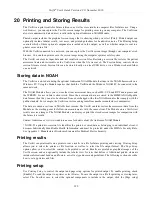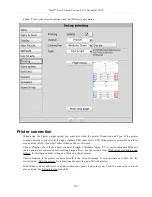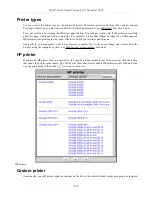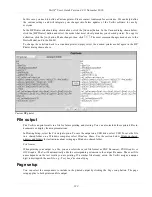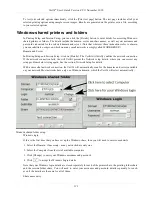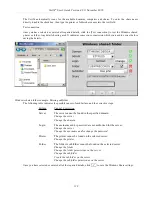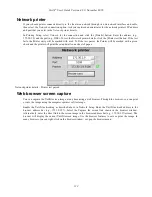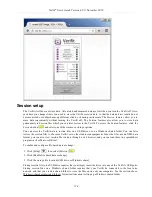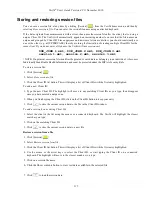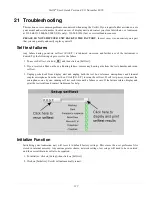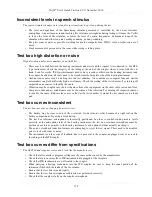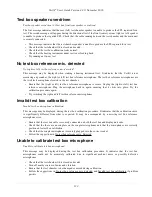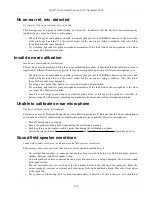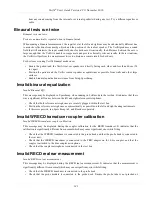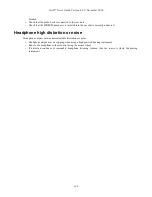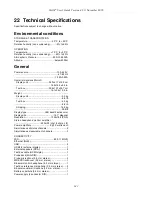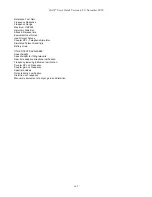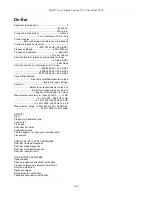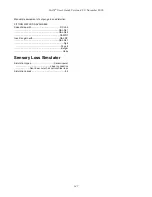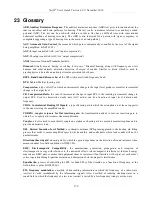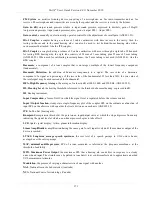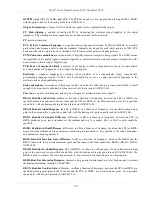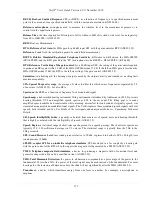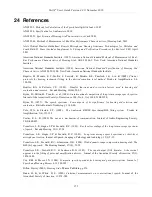
Verifit
®
User's Guide Version 4.8
©
November 2016
No on-ear ref. mic. detected
No (right or left) on-ear reference mic. detected.
This message may be displayed when starting an On-ear test. It indicates that the Verifit is not measuring any
sound at the on-ear probe reference microphone.
•
Check that a probe microphone assembly is securely plugged into the PROBE connector on the lower side
of the probe dock, and that it is the correct socket for the ear you are trying to calibrate. Also, check that
the cable has not become damaged.
•
Try switching right and left probe microphone assemblies. If the fault follows the microphone to the other
ear, it may be a faulty microphone.
Invalid on-ear calibration
Invalid on-ear microphone calibration!
This message may be displayed during the on-ear calibration procedure. It indicates that the calibration curve is
significantly different from what is expected. It may be accompanied by an on-ear reference microphone error.
•
Check that a probe microphone assembly is securely plugged into the PROBE connector on the lower side
of the probe dock, and that it is the correct socket for the ear you are trying to calibrate. Also, check that
the cable has not become damaged.
•
Try using a new probe tube. Ensure it is correctly attached and positioned.
•
Try switching right and left probe microphone assemblies. If the fault follows the microphone to the other
ear, it may be a faulty microphone.
•
Ensure not to attempt to use cleaned or sterilized probe tubes, as this causes the probe mic inlet tube to
become clogged with cerumen, requiring microphone replacement and voiding microphone warranty.
Unable to calibrate on-ear microphone
Unable to calibrate on-ear microphone!
This message may be displayed during the on-ear calibration procedure. It indicates that the on-ear microphones
could not be accurately calibrated due to significant ambient noise or possibly defective microphones.
•
Turn off nearby sources of noise.
•
Ensure the probe module is held steady during the calibration procedure.
•
Ensure nothing makes contact with the probe tube during the calibration procedure.
•
Follow the suggestions in No on-ear ref. mic. detected and Invalid on-ear calibration if problem persists.
Sound field speaker overdriven
Sound field speaker overdriven!
or
External sound field speaker overdriven!
This message may occur in on-ear directional or on-ear unaided or aided tests if:
•
No external front speaker is connected but one has been selected in Setup. See External display, printer,
speaker, External sound field speaker setup.
•
No back speaker has been connected but an on-ear directional test is being attempted. See External sound
field speaker setup.
•
The test environment is too reverberant for the distance between the client and the speaker(s). Move the
on-ear speaker(s), internal or external, and client away from walls and hard objects. Move the client closer
to the speaker(s).
•
The speaker or connecting cable (external speakers only) is defective. If this is the case, you should not
140
Summary of Contents for verifit
Page 1: ...Audioscan Verifit User s Guide 4 8 November 2016...
Page 17: ...Verifit User s Guide Version 4 8 November 2016 EC Declaration of Conformity 17...
Page 92: ...Verifit User s Guide Version 4 8 November 2016 92...
Page 94: ...Verifit User s Guide Version 4 8 November 2016 94...
Page 107: ...Verifit User s Guide Version 4 8 November 2016 Telecoil test results 107...
Page 123: ...Verifit User s Guide Version 4 8 November 2016 123...
Page 148: ...Verifit User s Guide Version 4 8 November 2016 148...
Page 149: ...Verifit User s Guide Version 4 8 November 2016 149...
Page 159: ...Verifit User s Guide Version 4 8 November 2016 159...

